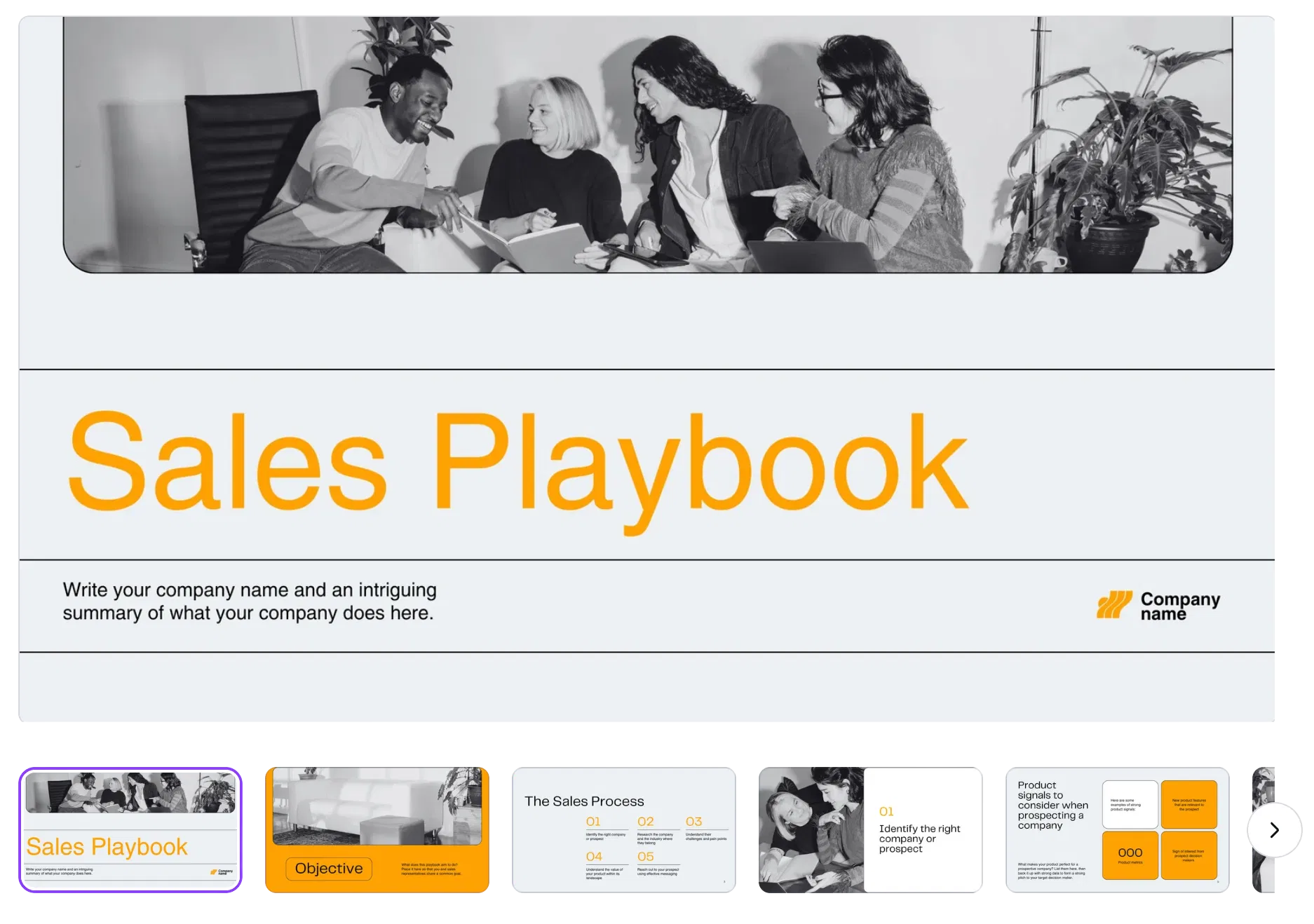The Ultimate Guide to Developing Sales Playbooks: Why You Need Them and How to Design Playbooks That Close the Deal

Every high-performing team, whether on the field or in business, relies on more than raw talent to win—they rely on preparation. Success doesn’t come from improvisation alone but from executing a well-rehearsed plan that guides every move toward a specific goal. The best organizations don’t leave growth to chance; they establish repeatable systems, document winning strategies, and ensure every member understands the steps that lead to victory.
Whether you aim to close more clients, strengthen collaboration between departments, or turn prospects into loyal advocates, you need a structured framework that defines how to succeed. That’s where a sales playbook comes in.
Table of Contents
What Is a Sales Playbook?
A sales playbook is the structured framework that guides your team through every stage of the selling process, from the first contact with a lead to closing the deal and nurturing long-term relationships. It’s the shared game plan that captures your organization’s most effective strategies, messaging, and methods, ensuring that every team member knows exactly how to approach a prospect, handle objections, and move opportunities forward.

At its core, a sales playbook turns experience into repeatable action. It takes what your top performers do best—how they qualify leads, tailor pitches, and overcome challenges—and documents those techniques so they can be learned, adapted, and scaled. A strong playbook transforms selling from a reactive process into a consistent system of execution.
Unlike one-size-fits-all scripts or outdated manuals, today’s playbooks are dynamic, digital, and data-driven. They integrate with your CRM, draw from real-time performance metrics, and evolve alongside your market and products. They are designed not just to tell salespeople what to do, but to help them understand why it works, giving them the context and confidence to adapt intelligently in every situation.
For growing businesses, it’s both a roadmap and a training guide—a single, living resource that connects strategy, execution, and measurable results.
Why You Need a Sales Playbook
Sales playbooks are essential tools for aligning strategy, standardizing execution, and driving consistent results. They serve multiple purposes across an organization.
- They improve performance: A well-structured playbook eliminates guesswork by giving sales reps repeatable steps that are proven to work.
- They accelerate onboarding: New hires can learn faster when best practices, scripts, and workflows are clearly documented.
- They create alignment: Marketing, management, and sales all use the same language, ensuring consistent messaging and brand presentation across every customer interaction.
- They enable scale: As your organization grows, your playbook provides the structure needed to replicate success across teams and territories.
- They save time: By streamlining repetitive tasks and providing ready-to-use templates, playbooks allow reps to spend less time preparing and more time selling.
How to Build an Effective Sales Playbook
The best playbooks are developed collaboratively, evolve, and include actionable content tailored to your sales process.
Review Your Sales Process
Start by mapping out your current sales process from beginning to end. What happens when a lead enters your system? How do you qualify, nurture, and close? Write down every step and identify areas that need improvement. Visualizing your process helps you see where to place specific plays that will make the most significant impact.
Understand Your Target Personas
Your sales playbook should include detailed buyer personas that help reps recognize ideal customers quickly. Define who you’re selling to, what motivates them, and what objections they commonly raise. These personas prevent wasted time chasing unqualified leads and help your team personalize their approach.
Identify Team Challenges
Talk with your sales reps and managers to understand where they struggle most. Do they find pricing conversations difficult? Are there objections they frequently encounter? By gathering input from your team, you can build plays that directly address those challenges and make their work easier.
Update and Audit Your Content
A strong playbook is powered by current, relevant content. Audit all your sales enablement materials—brochures, presentations, videos, articles, and templates—to ensure they reflect your latest messaging and data. Outdated resources can confuse prospects and undermine trust. Replace or refresh them regularly with what’s generating the best conversion rates.
Collaborate Across Departments
Building a great playbook requires insights from multiple teams. Work with marketing to include new collateral, talk with managers to identify key success factors, and collaborate with product teams to ensure accurate feature explanations. Your playbook should reflect how the entire organization supports the sales cycle.
Include Real-World Experience
A playbook should be more than theory. Document real examples of what’s worked before. Highlight strategies that led to wins, note the language that resonated with prospects, and identify the objections that were successfully overcome. This “field wisdom” makes the playbook relatable and actionable.
What to Include in a Sales Playbook
The most powerful playbooks provide clarity around who to target, what to say, and how to respond when prospects hesitate. They turn strategy into practical guidance for every selling situation.
- Ideal Customer Profile (ICP): Define your best-fit audience by describing the industries, business sizes, pain points, and goals that make an account a strong match. Knowing your ICP ensures reps focus on qualified opportunities instead of wasting time on poor fits.
- Buyer Personas: Humanize your ICP by mapping out the motivations, challenges, and priorities of individual decision-makers. These personas help reps tailor messaging to resonate emotionally and practically with each stakeholder.
- Unique Value Proposition (UVP): Articulate why your solution is different and better. Go beyond features—describe the business outcomes, efficiency gains, or revenue impacts you deliver. Your UVP should be simple, repeatable, and laser-focused on what your ICP values most.
- Objection Management: Every buyer has doubts, and your playbook should prepare reps to face them head-on. Common objections usually align with your ICP’s priorities—price sensitivity, implementation time, integration complexity, or perceived risk. Objection management isn’t about memorizing rebuttals—it’s about understanding your ICP deeply enough to anticipate their fears and respond with empathy and relevance. When done well, objection handling builds trust rather than friction. This section should include:
- Common Objections: Identify the top five to ten objections your team hears most often during discovery, demo, or negotiation stages.
- Underlying Concerns: Explain what these objections really mean (e.g., “It’s too expensive” may reflect uncertainty about ROI, not price itself).
- Recommended Responses: Provide short, tested responses that acknowledge the concern, reinforce value, and redirect the conversation toward the desired outcome.
- Proof Points: Include supporting evidence like case studies, testimonials, or data points that address each concern with credibility.
- Coaching Tips: Offer prompts or questions that help reps explore the objection further instead of reacting defensively (for example, Can you share what you’d need to see to feel confident in this investment?).
- Company Overview: Provide a brief summary of your mission, values, and narrative so reps can position the organization with authenticity and consistency.
- Product and Pricing Information: Detail product features, pricing tiers, and competitive comparisons so reps can confidently position value.
- Sales Process and Rules of Engagement: Define each stage of your sales funnel with clear goals, qualification criteria, and exit milestones.
- Templates and Scripts: Supply high-performing email templates, discovery call guides, and follow-up scripts.
- Checklists and Play Sequences: Include short, actionable task lists for each stage of the sales cycle.
- Performance Metrics: Outline measurable benchmarks to track progress and identify where additional training may be needed.
- Resources and Tools: Link to your CRM, case study library, ROI calculators, and supporting content.
Keep writing concise. Use bullet points, clear headings, and straightforward language. Simplicity encourages adoption. Avoid jargon, excessive formatting, or cluttered visuals that distract from usability.
Using Multimedia to Strengthen Engagement
Modern playbooks aren’t limited to documents or PDFs. They incorporate diverse media to make content easier to digest and share.
- Video tutorials and walkthroughs help visualize complex topics like software demos or objection handling.
- Interactive slides or infographics present data and workflows in engaging ways.
- Artificial intelligence (AI) can enhance this process, but it doesn’t have to dominate it. LLM-powered chatbots, for instance, can act as interactive assistants, walking sales professionals through key sections of the playbook, suggesting plays, or offering guidance during live conversations.
- Case studies, blog posts, and articles provide real-world examples that strengthen credibility.
- Sales calculators, comparison charts, and ROI tools allow reps to customize presentations for specific clients.
This multimedia approach allows your team to adapt presentations to different audiences and learning styles, making sales interactions more engaging and persuasive.
Streamlining Routine Activities with Templates and Workflow
Sales reps spend significant time preparing proposals, follow-ups, and presentations. By building templates and workflows into your playbook, you save time and reduce errors.
Automating repetitive tasks, providing ready-to-use frameworks, and offering clear directions help teams operate efficiently. For example, standardized onboarding sequences or follow-up email templates can be preloaded into CRM workflows. Time saved here directly translates into more time selling.
Providing Real-Time Guidance and Coaching
The most impactful playbooks don’t just teach; they coach. Modern tools allow sales teams to receive real-time guidance as deals progress. A digital playbook can deliver insights based on deal context, surfacing just the right information at the right moment.
This can include reminders to ask specific discovery questions, suggestions for talking points based on industry, or flags for helpful resources in a particular scenario. The goal is not to overwhelm reps with data but to provide just enough context to help them make smart decisions confidently.
Writing Plays That Drive Action
Great playbooks use clear, action-oriented language. Each play should start with a verb that tells the rep exactly what to do next. Examples include:
- Conduct discovery using open-ended questions to uncover needs.
- Provide a tailored demo that highlights value, not just features.
- Address objections using the LAER method (Listen, Acknowledge, Explore, Resolve).
- Confirm next steps by proposing a timeline for onboarding.
- Follow up with post-sale resources and check-ins to nurture long-term relationships.
These action-based plays keep teams focused on progress, not just process.
When to Create or Update Your Playbook
There’s no perfect time to start, but waiting too long means lost opportunities. Begin by reviewing existing materials, gathering templates, and writing down the essentials. Even a simple first draft can dramatically improve team alignment. Include:
- Company overview, mission, and values
- Product and pricing details
- Email, call, and follow-up templates
- Sales process rules and engagement guidelines
- Performance goals and KPIs
- Helpful tools and additional learning resources
Revisit your playbook regularly. Update it with new data, insights, and team feedback to keep it relevant and practical.
The Modern Playbook as a Living System
Today’s most successful organizations treat their sales playbooks as evolving assets. They blend structure, digital accessibility, and real-time coaching… all while empowering the sales representative to close the prospect creatively. The goal isn’t to create a rigid talk-track but to build an elegant system that supports every stage of selling and can be adapted to each team member’s style.
When everyone in the organization, from sales reps to marketing strategists, uses a unified playbook, the result is a faster, more innovative, and more cohesive sales operation. It’s how great teams, in sports or in business, win consistently.







